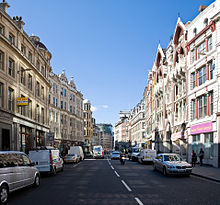Eastcheap

Eastcheap is a street in the City of London . Eastcheap is part of an east-west link through the City of London and is continued to the east by Great Tower Street and to the west by Cannon Street . In Eastcheap there are comparatively many historical buildings, so that Eastcheap and adjacent streets form the Eastcheap Conservation Area .
history
The first records of the street exist from the year 1100. Eastcheap is named after the market (formerly cheap or chepe in English). In medieval times, butcher shops were located on both sides of the street. London's most important meat and fish market took place on Eastcheap. The market for the western city took place on Westcheap Street, today Cheapside . The medieval road extended further west so that St Clement's Eastcheap church is no longer on the road today. On the other hand, the Eastcheap was added to Little Tower Street in the east in the 19th century.
The street became known literarily through William Shakespeare's play Henry IV , in which the pub Boar's Head on Eastcheap is the favorite pub of the antihero Falstaff . The play was probably performed in the pub itself during Shakespeare's time.
Eastcheap received its present form after the construction of the Metropolitan Line . The south side of the street was extensively redesigned between 1882 and 1884 in order to be able to build the subway line.
buildings
On the north side of the street are numerous Victorian buildings from the 1860s, including a few large warehouses. The south side was rebuilt in the 1880s and there are still numerous buildings on the street from this time.
- 11 Eastcheap - neo-Gothic building from 1881
- 19-21 Eastcheap - Former Drapers' Company in the City from 1881.
- 23 Eastcheap - former building of the spice merchant Hunt & Crombie from 1861 in Lombard neo-Gothic style. On the building is one of the smallest statues in London: two mice eating cheese.
- 25 Eastcheap - former pub from 1892 to 1893 by Young & Son
- 31 Eastcheap - also a Young & Son building, neo-Gothic.
- 33-35 Eastcheap , the former London warehouse of Hill & Evans vinegar producers . Built in 1868 by Robert Lewis Roumieu , and his most important work. According to the Buildings of England, " one of the most insane displays of neo-Gothic in London". According to architecture critic Ian Nairn, "the scream that wakes you up at the end of a nightmare." Stands on the site of the former Boar's Head.
Eastcheap Conservation Area
The Eastcheap Conservation Area has existed since 1976, and has been expanded several times (1981, 1991 and 2007). Since 2007 it has comprised the central and eastern part of Eastcheap, all of Lovat Lane and parts of Philpot Lane, Rood Lane, Botulph Lane, St Mary-at-Hill Street, Gracechurch Lane and St Dunstan-in-the Church -East .
Remarks
- ↑ a b c d Simon Bradley, Nikolaus Pevsner: London 1, The city of London, 1997, London: Penguin. ISBN 978-0-300-09624-8 , pp. 481-483
- ↑ a b City of London: Eastcheap Conservation Area .
- ↑ Mike Rendell: The Boars Head, Eastcheap: May 24th 1773. ( Memento of the original from December 30, 2013 in the Internet Archive ) Info: The archive link was automatically inserted and not yet checked. Please check the original and archive link according to the instructions and then remove this notice. , The Georgian Gentleman May 24, 2013
Web links
- City of London: Eastcheap Conservation Area
literature
- Simon Bradley, Nikolaus Pevsner: London 1, The city of London, 1997, London: Penguin. ISBN 978-0-300-09624-8 , pp. 481-483
Coordinates: 51 ° 30 '38.6 " N , 0 ° 5' 4.4" W.

